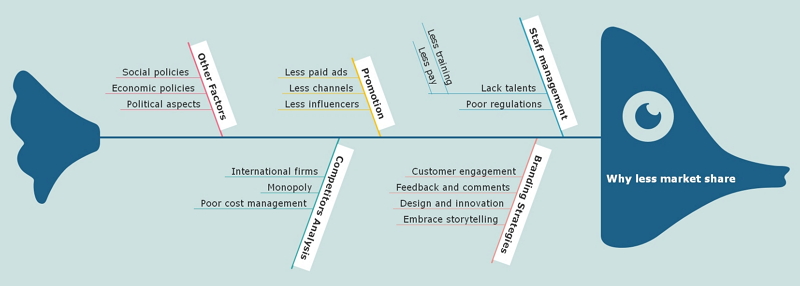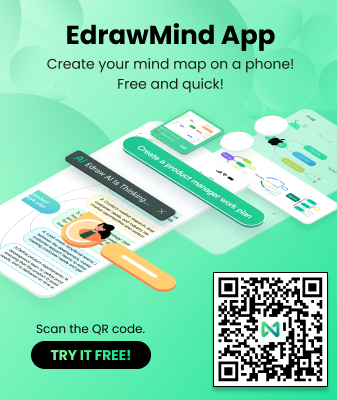How to Use Fishbone Diagram for Problem Solving
Fishbone diagram is a problem-solving tool, used in literal terms like a fishbone. It is also known as a cause and effect diagram. The mechanism is to specifically identify the cause and effect of any business or project problem.
A fishbone diagram can help define potential reasons for an issue. This article will dive into understanding the core principles of the fishbone diagram problem solving as a tool.
In 1943 at Tokyo University, Kaoru Ishikawa created the "Fishbone Diagram." Fishbone diagrams can also be called diagrams of "cause and effect." The fishbone diagram problem solving tool is a perfect tool to dig through an issue when we try to assess the root cause and find a solution effectively.
It offers a mechanism for explicitly identifying the "effect" and then brings you to think about the potential triggers, based on typical manufacturing problems. The fishbone diagram problem solving is a basic model that makes it easy to grasp swift and efficient root causes to implement corrective behavior.
It reflects the question or impact at the fish's head or mouth. Possible contributing factors under separate causal groups are identified on the smaller "bones." A fishbone diagram can help define potential reasons for an issue that would otherwise not be discussed by encouraging the team to look through the definitions and discuss alternate reasons.

Source: EdrawMind
1.1 Why Use Fishbone Diagram for Problem Solving
The fishbone diagram makes you consider more when solving specific problems. During a brainstorming activity, various groups inspire thoughts from different areas.
The fishbone diagram brings order to the process of cause and effect. It's easy for participants to understand the main problems or issues and focus on the question across different potential triggers.
The fishbone diagram helps distinguish the causes and reasons for a problem and lets people intuitively figure out the solutions.
1.2 The Usage of Fishbone Diagram
The fishbone diagram problem solving method can be used when trying to fix problems or discover the root cause of an issue or problem, which helps you to see below the surface, and dive deeper into the real problem.
Here are several typical fishbone diagram problem solving applications:
- Manufacturing:,nbsp;Uncover the root cause of a manufacturing problem by brainstorming and rating the likelihood and effect of all factors affecting the manufacturing cycle;
- Marketing or Product Marketing:,nbsp;Identify the possible factors that may impede your company's popularity in the marketplace by investigating all the places that affect your product acceptance;
- Service:,nbsp;Uncover the root cause of a business issue by brainstorming, and rate the probability and effect of all factors impacting the service delivery process.
There are 7 steps lead you to use fishbone diagram for problem solving:

Source: EdrawMind
- Explain the agenda behind the diagram
Let your team members know that the diagram can help you see different fields or possible areas that might lead to a solution to your current business problem.
- Draw diagrams
Draw the pattern or shape on your whiteboard, or use a software diagramming tool to ease accessibility. If you need remote attendants to do this exercise, you can quickly build it in EdrawMind and display your computer.
- Determine a simple statement on an issue
Write down statements at the top of your page or above where you will build the diagram., which means everyone has the same idea of the issue you are concerned with.
- Select what categories to use
Categories are discussed in more detail below. For example, you can add Policies, Methods, Personnel, and Software categories.
- Identify potential causes within each category of your problem
Team members may trigger brainstorming or contribute factors that fall into this category. You can either go by category or only come up with ideas and determine which type they fit.
- Go a step deeper to define sub-causes for any cause in the category
If you decide whether something can or will break down to smaller points, build divisions from the critical point.
Team members study the diagram to determine the most relevant focus points. If you are trying to take this a step forward and fix the root cause, it helps define where you're trying to benefit your initiative. You can't solve all the root factors at once, and some can get more significant payoff than others. Check the diagram for an evaluation of where the concentration of the team is best.
- Record results
You bring the work in. Capture, and log your work. You will need to return to it later, so you don't want to miss the importance of the exercise that you got.
There are several tips that should be considered when using the fishbone diagram for solving problems:
- Using the fishbone diagram tool to keep the team focused not on signs, but the problem's causes;
- Make sure you leave ample room in the diagram between the main groups to add minor specific pointers later;
- Try making team members write every cause on sticky notes while you're brainstorming causes, moving around the community asking each person about a particular reason. Continue to go through the loops, have more pointers before all suggestions have been eliminated;
- Encourage each person to join in the brainstorming exercise and voice their own opinions;
- Remember that the strategy of "five-whys" is often used in combination with the fishbone diagram.

Source: EdrawMind
While it takes time to create a fishbone diagram, it will help you and your team define the real causes and encourage you to strengthen the process and make permanent improvements.
Regardless, whether you are using the graphical or indented fishbone hierarchy, this process optimization method will significantly help you understand the factors involved in a process. The root causes of the event are the underlying process and system issues, which allowed the contribution. Hence fishbone diagram, the problem-solving tool, is extremely crucial when discussing strategies to deal with problems.
EdrawMind is an easy-to-use, flexible mind mapping tool designed to help you generate modern, fresh visuals and mind maps. By combining the bullet points into a mind map on a project, EdrawMind lets you organize the thoughts or concepts and create essential strategies.







